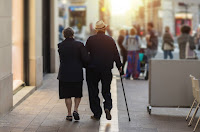How funny and strange to see people who seem to have walked out of a different century. Today, I stopped for a woman at a crosswalk in a small shopping area, pushing a cart filled with groceries. She was older--but how old could she be compared to me? Not that old. The woman wore a scarf on her head knotted under her chin and what appeared to be an apron over pants and a thick woolen sweater. All in black, not your typical Saturday afternoon outfit for a female in a Maryland suburb of Washington D.C. She crossed the street slowly, as if there was nothing special about taking a Giant shopping cart out of the parking lot. Other people occasionally take carts off the property, but her posture and movement were different. She was crouched over a bit and pushed the heavy load. Somehow, she brought to my mind a woman working her way home in a small European village.
Her husband or male companion followed. He struck out his hands to halt traffic. I already had stopped my car. This action reminded me of manual traffic control in a tiny town without lights or signs. He, too, seemed out of our world. I thought--Tevye or Zorba. He wore a black fisherman's cap, baggy trousers, and a heavy woolen sweater. His shoes were clunky, and he walked slowly with slightly bent knees.
When I see people like these--minding their own business, not bothering a soul--I think where did they come from? Maybe somewhere in the former Soviet Union where time has stood still. This couple was Caucasian, so I ruled out Asia and Africa.
I used to live in a area of North Bethesda that has a relatively high population of Sephardic Jews. The reason is the sephardic synagogue. Nearly everyday, a group of elderly men and women congregated nearby. They strolled, shopped, and perched on benches to converse. I say elderly, but I am what is considered elderly. These individuals dressed in a fashion that I associated with my grandmothers. The women wore scarves on their heads, skirts, and proper shoes, for example plain pumps with a small heel or tied oxfords. The men, weatherworn and wrinkled, wore caps, slacks, and zipper jackets.
Their slow pace seemed to hearken back to fifty or more years ago. They did not speak English. I could not catch what language they spoke. Old world emanated from them. But where is the old world? We are one world now. Had they lived in a village in Turkey, Portugal, Georgia near the Black Sea? I am mystified. No one I know strolls, shops, strolls, and sits on benches.
Healthy--lucky--American adults in their seventies and eighties walk for exercise quickly--swinging their arms in an effort to increase heart rate and wearing athletic outfits. If we talk, we converse as we move, somewhat breathlessly I might add. Benches? No time for that. When we shop, we usually load groceries into a car, carry our food back to our nearby residences in reusable bags, or pull a brightly colored Whole Foods shopping cart, purchased for $29.99.
The self-sufficient friendly "aliens" I notice are, in fact, models for how we should live, especially those of us "of a certain age." We should slow down and stroll everywhere for our health but also for the environment. Strolling decreases the chances for tripping over curbs, bumps, holes, and uneven pavement. The benches are around us for a purpose. Why are we not using them? Where are we hurrying to?
I confess, I am trying to stuff in as much living as is possible before disaster strikes, as in illness. But are we not living in a fairly disastrous world? I think, if only I do this, that, and the next activity. There is no stopping time. I am what I am. I am acting as I think is best. But, I keep going. The elderly folks who seem so old-fashioned, certainly my age, probably view me as the alien. Why is she in a rush, they might ask? Slow down, say hello, and smell the roses. I do smell flowers and notice nature, but I keep moving rapidly.




